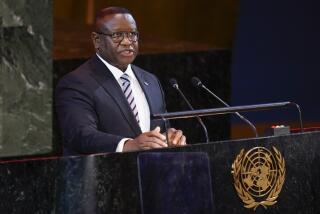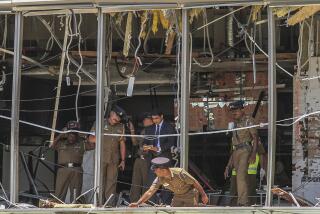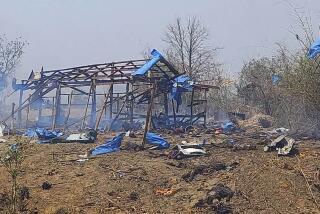Rebels Down 2 Sri Lankan Planes; 97 Die : South Asia: President must now decide whether to try reviving peace talks or go all out on battlefield.
- Share via
NEW DELHI — In a sharp and sudden escalation of Sri Lanka’s ethnic blood bath, Tamil separatists used surface-to-air missiles for the first time to shoot down two air force transport planes, killing 97 people, officials said Saturday.
The back-to-back air disasters Friday evening and Saturday in the rebel-controlled Jaffna peninsula were unexpected proof that government forces in the Indian Ocean island nation no longer have unchallenged mastery of the skies.
The attacks also posed an urgent question for President Chandrika Kumaratunga, who must decide whether to try to revive peace talks with the Liberation Tigers of Tamil Eelam, or LTTE, that collapsed with a resumption of fighting earlier this month or to go all out on the battlefield.
Friday evening, a twin-engine Avro troop transport of the Sri Lankan air force crashed in flames while taking off from Palali military base in the northern Jaffna peninsula, where for the past 12 years Liberation Tiger insurgents have been fighting for a separate homeland for the Tamil minority.
Sri Lankan military sources at first called the crash of the British-designed aircraft an accident. But Saturday, they confirmed widespread rumors that the plane had been hit by a missile.
All 45 aboard were killed, including the air force northern zone commander, Wing Cmdr. Roger Weerasinghe, officials said.
Ironically, the doomed Avro was also carrying the corpses of eight soldiers who had been killed by separatists in a Thursday night attack on a bunker on a small island off the Jaffna peninsula.
Saturday, a second Avro was knocked down about four miles from Palali as it approached for a landing. This time, ground troops clearly saw the transport struck by a heat-seeking missile, Sri Lankan officials said.
“Missile attack!” was the final message radioed by the pilot, Shirantha Goonetillke, after his aircraft was hit at 5,000 feet.
A military communique said all 52 people on board, including three journalists from the state-run Lake House group of newspapers, were killed when the plane crashed about a mile from the base’s defense perimeter.
*
The dead included 30 Sri Lankan army personnel, 12 from the air force, five from the navy and two policemen.
Observers said the missile attacks marked a watershed in the civil war that has cost more than 30,000 lives, because beleaguered government forces on bases in the Jaffna peninsula depend largely on supplies and support from the air.
Without overwhelming dominance of the skies, the ability of those troops to hold out against the Liberation Tigers, let alone to keep them from making more territorial gains, is considered doubtful at best.
“Looking at the problem objectively, the LTTE have now broken the air and naval superiority of the government,” Jayadeva Uyangoda, professor of political science at Colombo University, said Saturday. “The conflict has entered a qualitatively new phase.”
The use of a new type of weapon against aircraft also strongly suggested that the Tigers exploited a three-month truce to secretly beef up their forces.
“The situation is very fluid, and it is very difficult to say what course it will now take,” Ajith Samaranayake, editor of the Sunday Observer newspaper, said. “One tends to wonder where they got such a caliber of weapon.”
Kumaratunga was elected Sri Lankan president Nov. 9 on her promise to seek a negotiated end to the war, one of the longest-running ethnically rooted conflicts in the world.
Until fighting resumed 11 days ago, a cease-fire had been in effect since Jan. 8 between her government and the Liberation Tigers.
The LTTE’s leader, Vellupillai Prabhakaran, is renowned for his cleverness and ruthlessness. The 40-year-old Tamil may have been the sole foreign figure of stature to purport to understand the motives behind the devastating April 19 bombing of the federal building in Oklahoma City.
“It is when people are downtrodden and have no hope of redress that they are forced to resort to such violent means through remorse, frustration and despair,” Prabhakaran said in a letter to U.S. Ambassador Teresita Schaffer, news reports said.
*
The Liberation Tiger chief had warned that he would break off 6-month-old peace negotiations with the government unless Kumaratunga quickly granted various demands, including dismantling a strategically important military base at Pooneryn and allowing rebels to carry firearms in Tamil areas of eastern Sri Lanka.
When those concessions did not materialize, Prabhakaran’s forces shattered the cease-fire.
Early on the morning of April 19, a four-member LTTE suicide squad slipped into the government’s naval base at Trincomalee and blew up two Chinese-made gunboats moored at the pier.
A dozen sailors were killed and 23 injured.
Kumaratunga and her government are bracing for more trouble as Sri Lanka prepares for the May Day holiday, an occasion when political parties and labor unions on the island customarily hold large rallies and parades.
Two years ago, a suicide bomber on a bicycle, widely suspected to have been a Tamil militant, assassinated President Ranasinghe Premadasa as he led a May Day procession in Colombo, the capital.
Since the collapse of the talks between the government and the LTTE, police have been warning Sri Lankans that this year’s parades could also be marred by violence.
“There will be no restrictions on rallies,” police spokesman Trelawny de Silva told reporters. “But we are asking the public to be vigilant, since it is possible the Tigers may try bomb attacks.”
Kumaratunga, who charges that the Liberation Tigers are now trying to assassinate her, has not said whether she will address the Monday rally of her People’s Alliance coalition.
Tamils, who are generally Hindus and Christians, make up 17% of Sri Lanka’s population of 17 million. Many complain of exploitation and domination by the country’s largest group, the predominantly Buddhist Sinhalese.
More to Read
Sign up for Essential California
The most important California stories and recommendations in your inbox every morning.
You may occasionally receive promotional content from the Los Angeles Times.










